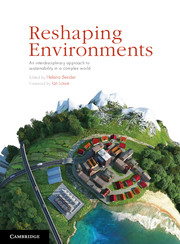Book contents
- Frontmatter
- Contents
- Contributors
- Acknowledgements
- Introduction Reshaping environments – an opportunity for envisioning the future
- Part 1 Cases
- Part 2 Skills
- 9 Critique, analysis and reflection in the study of reshaping environments
- 10 Working with complex issues in group situations
- 11 Understanding research methodology
- 12 An interdisciplinary approach
- Part 3 Theory
- Index
- Plate Section
- References
12 - An interdisciplinary approach
from Part 2 - Skills
Published online by Cambridge University Press: 05 February 2013
- Frontmatter
- Contents
- Contributors
- Acknowledgements
- Introduction Reshaping environments – an opportunity for envisioning the future
- Part 1 Cases
- Part 2 Skills
- 9 Critique, analysis and reflection in the study of reshaping environments
- 10 Working with complex issues in group situations
- 11 Understanding research methodology
- 12 An interdisciplinary approach
- Part 3 Theory
- Index
- Plate Section
- References
Summary
Introduction
Because the environment is a complex, multidimensional system it gives rise to ‘wicked’ problems which cannot be fully understood or solved from a single disciplinary perspective, approach or method (see the Introduction for more discussion of ‘wicked’ problems). Although each discipline can give a partial perspective and make a contribution towards a solution, no discipline can provide a complete picture of how to shape, reshape, manage and sustain the urban, social and natural environment. Architects tell us how to design a space to meet our needs, but do not tell us about the possible effects on the local ecology. Engineers can tell us the most efficient way to transport or store water, but not the preferred way. Sociologists can tell us what particular people want, but they cannot tell us how to build it. Ecologists can describe the effects of our actions on an ecosystem, but they cannot tell us how to balance our needs and wants against those of the ecosystem. Economists can tell us what will be the most cost-effective path to take, but not what leads to the least environmental harm (see Box 12.1 for more about disciplines).
- Type
- Chapter
- Information
- Reshaping EnvironmentsAn Interdisciplinary Approach to Sustainability in a Complex World, pp. 256 - 274Publisher: Cambridge University PressPrint publication year: 2012
References
- 3
- Cited by



